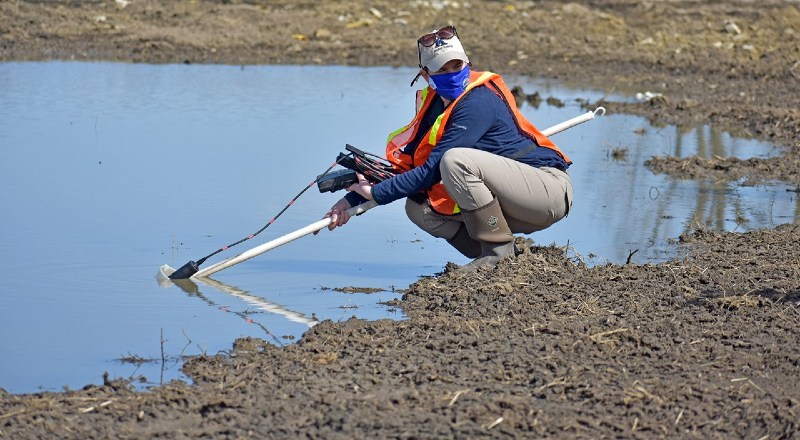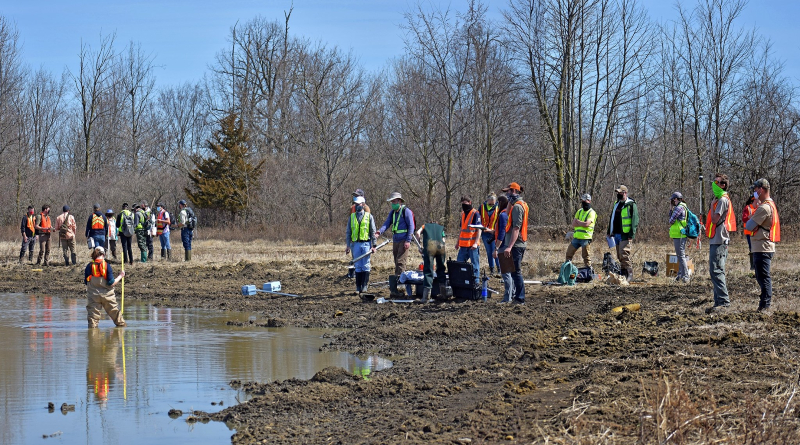H2Ohio “Dream Team” Shapes Monitoring Protocol At Oakwoods
More than two dozen scientists from a variety of universities in Ohio recently gathered at the Hancock Park District’s Oakwoods Nature Preserve just west of Findlay to develop a monitoring program for the wetlands that are being implemented as part of the state’s H2Ohio initiative.
Get full details in the following news release from the Hancock Park District.
Ohio Governor Mike DeWine unveiled H2Ohio on November 14, 2019, as a comprehensive, data-driven water quality plan to reduce harmful algal blooms, improve wastewater infrastructure, and prevent lead contamination. On March 22, 27 scientists representing six Ohio universities gathered at Hancock Park District’s Oakwoods Nature Preserve (ONP) to develop a monitoring program for all of the wetlands implemented by the Ohio Department of Natural Resources (ODNR) as part of the H2Ohio initiative. Following Mondays meeting the group will put expertise and sampling equipment to the test at the 48 sites currently related to the H2Ohio initiative, all with the common goal of discovering just how effective wetlands are at intercepting nutrient-laden surface water in the Lake Erie Watershed.
Eric Saas, H2Ohio Program Manager with ODNR, was in the thick of the wader-wearing throng. “This is the first time that weve gotten these researchers together in person,” he said, citing previous weekly Zoom calls as precedent.
The ONP Wetlands Restoration Project, funded in 2020 during Phase 1 of H2Ohio, includes a number of different habitats that support studies for the educational community. The east portion of the project sits in an agricultural field that is being converted into a number of shallow wetlands that may be completely dry for most of the summer and fall. These vernal (spring) pools serve as essential breeding habitat for certain species of wildlife, including amphibians that are an important food source for small carnivores as well as large game species. Wetlands in the west project will hold water most of the year as adjacent Aurand Run feeds water into the pools during overflow events.
“Thats why we chose this site,” explains Dr. Robert Midden, Adjunct Research Professor at Bowling Green State University (BGSU). “Weve got the opportunity to do most of the types of sampling that we need to do.”
Because of the close proximity to ONP, BGSU will perform most of the wetlands monitoring there. However, Dr. Lauren Kinsman-Costello, Assistant Professor of Biological Sciences at Kent State University, leads this dream team of scientists. She did her dissertation on phosphorous cycling in wetlands and is conducting active research projects that are relevant to the H2Ohio initiative. But Kinsman-Costello notes that the program is very much a group effort.
“There are so many different kinds of wetlands and so many ways that they can be restored. Its almost like comparing apples to plums to grapes to, like, Kool-aid,” she laughs. “Were trying to figure out how to create a program thats flexible but also standardized enough that we can come up with data thats really comfortable for all. We dont really know of any other monitoring program in the United States that does that specifically for this many types of wetlands.”
Kinsman-Costello voices the group’s hope that there will be other researchers that use their program as a foundation to study all of the other benefits that wetlands provide. “Wetlands can improve water quality, create habitat, wonderful spaces for people to be in and we want to make sure that wetland restoration is done in a science-based way. Are these tax dollars well-spent in terms of nutrient removal and what can we do better.”
Saas adds that H2Ohio is looking forward to additional phases of the wetland restoration work as his department estimates that the current number of project sites is about a third of what must be done to remove nutrients and prevent excess nutrients from getting downstream. In addition to ODNRs push for wetland creation, restoration or enhancement projects, the H2Ohio initiative includes partnerships with the Ohio Department of Agriculture to promote widespread adoption of best management practices and with the Ohio Environmental Protection Agency to fund water infrastructure projects and to address failing home sewage treatment systems, all with the goal of improving water quality. For more information, visit h2.ohio.gov.
For further information about the ONP Wetlands Restoration Project or other HPD Programs and Activities, visit HancockParks.com or call the HPD Administrative Office at 419-425-7275.


